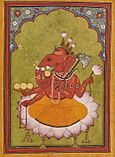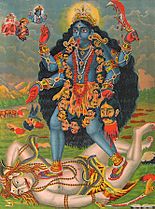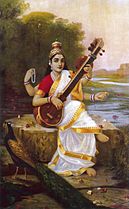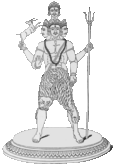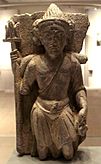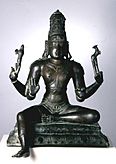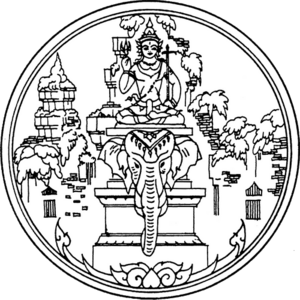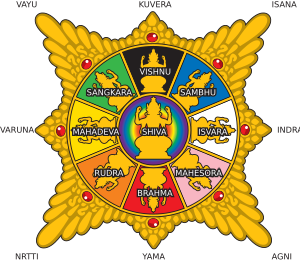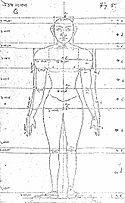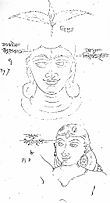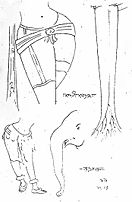Hindu deities facts for kids
Hindu deities are the gods and goddesses in Hinduism. People use different names for them. Some common names are Deva (for male gods) and Devi (for goddesses). Other names include Ishvara and Bhagavān.
Hindu deities have changed over a long time. Their stories come from the Vedic era (around 2000 BCE) to today. They are important in Nepal, Pakistan, India, and Southeast Asia. Some Hindus believe in one personal god. Others believe in many gods, like the 33 main gods in the Vedas. The Puranas mention hundreds of deities.
Important Hindu deities include Vishnu, Lakshmi, Shiva, Parvati, Brahma, and Saraswati. Each deity has a special personality. But many Hindus see them as different parts of one great power called Brahman. Hindus have always believed that all gods are connected. For example, Harihara is shown as half Vishnu and half Shiva. Ardhanārīshvara is half Shiva and half Parvati. This shows they are seen as the same.
Many Hindu traditions focus on specific deities. For example, Vaishnavism worships Vishnu. Shaivism worships Shiva. Shaktism worships Devi (the Goddess). But they all share similar stories, rituals, and art. Some traditions, like Smartism, see many main deities as different forms of Brahman.
Hindu deities are shown in many ways. They appear in paintings and sculptures called Murtis. Some ancient Hindu groups did not believe in any gods. In the 1800s, some groups like the Arya Samaj focused on one God, like in Abrahamic religions. Hindu deities are also found in other religions like Jainism. They are also honored in places like Thailand and Japan.
Ancient Hindu texts say the human body is like a temple. Deities live inside it. They also say that Brahman (the main God) is like the Atman (the Self) inside every living thing. Hindus can choose to believe in many gods, one God, or no God. They can also be agnostic (not sure) or atheistic (not believing in God).
Contents
Devas and Devis: Gods and Goddesses
In Hinduism, male deities are called Deva. Female deities are called Devi. These words mean "heavenly" or "divine."
In very old Vedic writings, all powerful beings were called Asuras. Later, good powerful beings were called Deva-Asuras. In newer Hindu texts, Devas are usually good. Asuras are usually bad. Sometimes, Devas are called Suras. They are seen as good, while Asuras are their powerful but bad half-brothers.
Hindu deities, both Devas and Devis, are part of Indian mythology. They appear in many Hindu stories about how the universe works.
Vedic-Era Deities
In the old Vedic texts, Devas and Devis represent nature's powers. They also stand for good values. Each one shows special knowledge, creative power, or magic.
The most common Devas in the Rigveda are Indra, Agni (fire), and Soma. Agni, the fire god, is seen as a friend to all people. Agni and Soma are important in a fire ritual called yajna. This ritual is part of many Hindu ceremonies. Other gods like Savitr, Vishnu, Rudra (later called Shiva), and Prajapati (later Brahma) are also Devas.
The Vedas also describe many important Devis. These include Ushas (dawn), Prithvi (earth), Aditi (cosmic order), Saraswati (river, knowledge), and Vāc (sound). Other goddesses like Nirṛti (destruction), Ratri (night), and Aranyani (forest) are also mentioned. Sri, also called Lakshmi, appears in later Vedic texts. In later Hindu writings (after 500 BCE), all gods and goddesses are seen as parts of one Brahman, the Supreme power.
Ananda Coomaraswamy says that Devas and Asuras are like the Angels and Titans in Greek stories. Both are powerful. But Devas represent light, and Asuras represent darkness. Coomaraswamy believes that both these sides exist in every person. The good and bad in us are always fighting. The Hindu idea of Devas and Asuras shows this endless struggle within each person.
Medieval-Era Deities
In the Puranas and the Itihasas (like the Bhagavad Gita), Devas are good and Asuras are bad. The Bhagavad Gita says that all beings have both good (divine) and bad (demonic) qualities. It says that truly good or truly evil people are rare. Most people have a mix of both. The Gita explains that desires, greed, and emotions are normal. But when they become hate, arrogance, anger, or cruelty, they turn into something demonic (Asura).
The Epics and medieval texts, especially the Puranas, have many rich stories about Hindu deities. These stories include their family trees. Several Purana texts are named after major Hindu deities like Vishnu, Shiva, and Devi. Other texts say that Hindu deities live in the cosmic body and also in the human body. They say that the Sun deity is the eyes, and Vāyu is the nose.
Symbolism of Deities
Gods and anti-gods in Hinduism are symbols for spiritual ideas. For example, the god Indra (a Deva) and the anti-god Virocana (an Asura) both seek wisdom. Virocana quickly takes the first answer. He thinks he can use knowledge as a weapon. Indra, however, keeps asking questions. He learns about true inner happiness and power. This shows that the Deva-Asura ideas can be seen as "stories about tendencies within ourselves." Hindu deities in the Vedic era were seen as having "powerful inner, creative mental powers."
In Hindu stories, everyone starts as an Asura. They are born from the same father. "Asuras who stay Asura" want more power, wealth, and are often angry or violent. "Asuras who become Devas" listen to their inner voice. They seek understanding and peace. They prefer balance, good behavior, knowledge, and harmony.
The god (Deva) and anti-god (Asura) also symbolize the opposite forces that drive each person. So, the Deva-Asura idea is a spiritual concept. It is not just about family groups. In the Bhāgavata Purana, saints and gods are born into Asura families. This shows that your actions and beliefs define if you are Deva-like or Asura-like. It is not about your birth or family.
Ishvara: The Supreme Being
Another Hindu term for deity is Ishvara. Sometimes, different deities are seen as "forms of one and the same Ishvara." The word Ishvara has many meanings. It depends on the time period and the Hindu school of thought. In old Indian texts, Ishvara can mean supreme Self, Brahman (Highest Reality), ruler, or king. In medieval texts, Ishvara means God, Supreme Being, or a personal god.
Some Hindu philosophies, like Samkhya and Mimamsa, do not focus on Ishvara. They do not see a supreme being as important. Other schools, like Yoga, Vaisheshika, Vedanta, and Nyaya, discuss Ishvara. But they give it different meanings.
In the Yoga school of Hinduism, Ishvara is any "personal deity" (Ishta Deva). It is a "spiritual inspiration," but not a creator God. Patanjali's Yoga Sutras can be understood in different ways. But Ishvara in Yoga helps the yogi on their path to spiritual freedom.
The Advaita Vedanta school says there is no difference between a deity and a person. God (Ishvara, Brahman) is the same as the Atman (Self) inside each human. This school believes in one Universal Oneness that connects everything.
Number of Deities
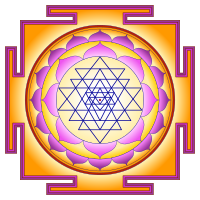
Sri Yantra symbolizing the goddess Tripura Sundari
|
|
| Yantras or mandalas (shown) are 3-D images. In Tantra, a small Hindu tradition, they are seen as the same as a deity. Similar yantras are found in Jainism and Buddhism. |
Yāska, an early Indian language expert (around 500 BCE), said there are three main deities in the Vedas: Agni (fire) on earth, Vayu (wind) in the air, and Surya (sun) in the sky. This idea of three worlds appears in many old texts. The Samhitas, the oldest part of the Vedas, list 33 devas. These are often 11 for each of the three worlds. Or they are listed as 12 Adityas, 11 Rudras, 8 Vasus, and 2 Ashvins.
The Rigveda says in hymn 1.139.11:
O ye eleven gods whose home is heaven, O ye eleven who make earth your dwelling,
Ye who with might, eleven, live in waters, accept this sacrifice, O gods, with pleasure.
– Translated by Ralph T. H. Griffith—Rigveda 1.139.11
One or Oneness
Other ancient texts, like the Yajurveda, mention 33 koti (supreme) divinities. Koti can mean "type" or "crore" (ten million). Most of these are goddesses. This shows how important goddesses are in Hindu culture. Scholars say that all deities in Hinduism are usually seen as "forms or parts of a genderless principle called Brahman." They represent the many sides of the Ultimate Reality.
This idea of God in Hinduism means "God, the universe, humans, and everything else is one thing." Everything is connected. The same God is in every human being as Atman, the eternal Self.
Icons and Worship
Hinduism has a very old tradition of using images. These are called Murti (Sanskrit: मूर्ति), or Vigraha. A Murti is not the god itself. It is an image of the god. It holds emotional and religious meaning. Calling a Murti an "idol" is not quite right. An idol might mean it's just a superstitious object. But a Murti is like a photo of a person. The photo is not the real person. But it reminds you of someone important. When a person worships a Murti, they believe it shows the spirit of the deity. The worshipper's spiritual ideas are thought about through the image. But the ultimate reality, Brahman, is not limited to the image.
A Murti of a Hindu deity is usually made from carved stone, wood, or metal. Old texts describe how to make them. They explain the right sizes, poses, and hand gestures. The expressions on a Murti can vary. Some show destruction, fear, or power (like Durga, Parvati, Kali). Others show joy, knowledge, and peace (like Parvati, Saraswati, Lakshmi). Peaceful images are most common in Hindu temples. Other forms include the Linga.
A Murti is a form of the divine. It represents the Ultimate Reality or Brahman for some Hindus. They are found in Hindu temples or homes. There, they are treated like a special guest. They are part of Puja rituals. Priests place a murti in temples during a special ceremony. This ceremony is believed to bring the "divine energy of the cosmos" into the sculpture. Then, the divine is welcomed like a friend. Sometimes, a murti is the main focus of yearly festival parades. These are called Utsava Murti.
Temple and Worship
In Hinduism, deities and their images can be in a Hindu temple, in a home, or as a charm. The worship Hindus do is called Puja. This practice in front of a murti can be grand in big temples. Or it can be a simple song or prayer at home. It can also be an offering made to the sunrise or a river. Old records show Puja rituals in Hindu temples from around 400 CE. In temples, different pujas might happen daily. In other temples, they happen sometimes.
The Puja is like welcoming, hosting, and honoring a deity as a special guest. It helps the worshipper remember the spiritual meaning of the deity. A typical Puja has 16 steps. The deity is invited as a guest. The worshipper takes care of the deity. Praises (hymns) are offered with incense or light. Food is also offered. After showing love and respect, the host says goodbye to the deity. Worship can also involve thinking about spiritual questions. The image helps with this meditation.
Worship (Bhakti), visiting temples, and Puja are not required in Hinduism. It is a choice for each Hindu. For some, it is a daily habit. For others, it is a regular ritual or happens less often. Worship in Hinduism is as varied as its traditions. A Hindu can choose to believe in many gods, one god, or no god.
Examples of Deities
Major deities have inspired many stories and texts. These include the Puranas and Agama texts. They also led to different Hindu traditions. But these traditions share stories, rituals, and art. Vishnu and his forms are central to Vaishnavism. Shiva is central to Shaivism. Devi is central to Shaktism. Some Hindu traditions, like Smarta, honor many major deities. They see them as different forms of Brahman (the ultimate reality).
There are many different deities in Hinduism. But it is rare for Hindus to say "only my deity is real." Hindus usually accept and respect other deities. This is a common way of life in Hinduism.
Trimurti and Tridevi: Three Main Deities
The idea of a Triad (or Trimurti, meaning Trinity) appeared later in Hindu writings. This idea of three gods playing three roles in the universe is usually linked to Brahma, Vishnu, and Shiva. Brahma creates, Vishnu preserves, and Shiva destroys. This balance helps the universe work.
However, this is not the only triad in Hindu texts. Another triad is Tridevi, which means three goddesses. These are Lakshmi, Saraswati, and Parvati. In the Shakta tradition, these goddesses are seen as the Brahman (Ultimate Reality). Their energy gives power to Brahma, Vishnu, and Shiva. Other triads in old Indian texts include Sun (creator), Air (sustainer), and Fire (destroyer).
These triads are sometimes grouped without being a formal Trinity. Other times, they are seen as equal. They are a unity and different forms of one Brahman. For example, the Puranas say:
They [Brahma, Vishnu, Shiva] exist through each other, and uphold each other; they are parts of one another; they subsist through one another; they are not for a moment separated; they never abandon one another.
—Vayu Purana, 5.17, Translated by Jan Gonda
The Bhagavad Gita says that the triad is a form of one Brahman. Krishna says he is this Brahman. But the idea of the triad is not the most important one in Hindu traditions. Instead, spiritual ideas grow on their own.
Avatars of Hindu Deities
Hindu stories have the idea of an Avatar. This means a deity comes down to earth. It is often called an "incarnation" or an "appearance."
The idea of Avatar is most developed in the Vaishnavism tradition. It is linked to Vishnu, especially to Rama and Krishna. Vishnu has many avatars in Hindu stories. He can even become female, like Mohini, to help solve problems between Devas and Asuras. His male avatars include Matsya (fish), Kurma (turtle), Varaha (boar), Narasimha (half-man, half-lion), Vamana (dwarf), Parashurama, Rama, Krishna, Buddha, and Kalki. Many texts, especially the Bhagavad Gita, say that Vishnu's Avatars appear to bring balance back to the world. This happens when evil becomes too strong.
In Shaktism traditions, the idea of Avatar appears as different forms of Devi. Devi is the Divine Mother in Hinduism. The avatars of Devi or Parvati include Durga and Kali. They are especially honored in eastern India. Twenty-one avatars of Shiva are also described in Shaivism texts. But Shaiva traditions focus more on Shiva himself, not just his avatars.
Major Hindu Deities Across India
| Name | Other Names | Avatārs or Associated Deities | Geography | Image | Early illustrative art |
|---|---|---|---|---|---|
| Vishnu | Nārāyana, Venkateshwara, Jagannatha Dattatreya, Hari, Other names of Rama and Krishna |
Matsya, Kurma, Varaha, Narasimha, Vamana, Parashurama, Rama, Krishna, Kalki, Vithoba, Perumal, Balarama, Mohini, Buddha, Hayagriva | India, Nepal, Sri Lanka |  |
2nd century BCE |
| Shiva | Mahādeva, Pashupati, Tripurantaka, Vishwanatha, Dakshinamurthy, Kālāntaka, Bhairava, Rudra, Nataraja, Sadashiva, Dattatreya |
Batara Guru (Indonesia) Achalanatha (Japan) |
India, Nepal, Sri Lanka | 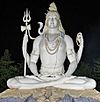 |
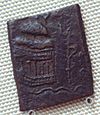 1st century BCE |
| Brahmā | Aadi-Prajāpati, Virinci, Vaidyanaatha, Vakpati, Varishta-deva, Kamalaja, Srashtaa, Kartaa, Dhaataa | Bonten (Japan), Phra Phrom (Thailand) |
India, Nepal, Sri Lanka, Southeast Asia | 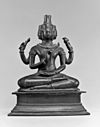 |
 6th century CE |
| Ganesha | Ganapati, Vināyaka, Lambodara, Gajānana | Kangiten (Japan) | India, Nepal, Sri Lanka | 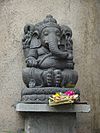 |
 7th century CE |
| Kārtikeya | Skanda, Murugan, Mangal, Kumaraswamy, Subramanya, Shanmuga | India, Sri Lanka, Malaysia, Nepal | 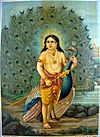 |
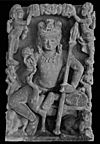 2nd century BCE |
|
| Pārvati | Uma, Devi, Gauri, Durga, Kāli, Annapurna |
Umahi (烏摩妃, Japan) Dewi Sri (Indonesia) |
India, Nepal, Sri Lanka | ||
| Lakshmi | Sri Devi, Gajalakshmi, Kamalāsanā | Sita, Radha, Kisshōten (Japan) Nang Kwak (Thailand) |
India, Nepal, Sri Lanka | 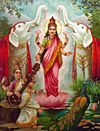 |
 1st century BCE |
| Saraswati | Vāgishvari, Vīnāpāni, Sharda | Benzaiten (Japan), Biàncáitiān (China), Thurathadi (Myanmar), Suratsawadi (Thailand) |
India, Nepal, Java, Bali, Sri Lanka | 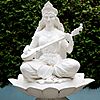 |
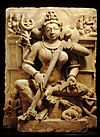 10th century CE |
| Durgā | Pārvati, Kāli, Mahishāsuramardini |
Betari Durga (Indonesia) | India, Nepal, Sri Lanka |  |
 8th century CE |
| Kāli | Durga, Parvati | India, Nepal, Sri Lanka |  |
||
| Mariamman | Durga, Parvati | India (mostly in South India), Southeast Asia, Sri Lanka |
 |
 10th century CE |
|
| Harihara (Half Vishnu - Half Shiva) | ShankaraNarayana | India, Sri Lanka, Nepal |  |
 6th century CE |
|
| Ardhanārīshvara (Half Shiva - Half Parvati) | India, Nepal, Sri Lanka | 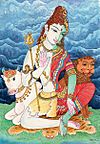 |
 1st century CE |
||
| Hanuman | Anjaneya, Maruthi, Bajarangbali, Langura, Sankatmochan, Pavanasut | India, Nepal, Sri Lanka |  11th century CE 11th century CE |
Images for kids
See also
 In Spanish: Divinidades hinduistas para niños
In Spanish: Divinidades hinduistas para niños
- Hindu denominations
- Hindu iconography
- Hindu mythology
- Puranas
- List of Hindu deities
- Rigvedic deities


